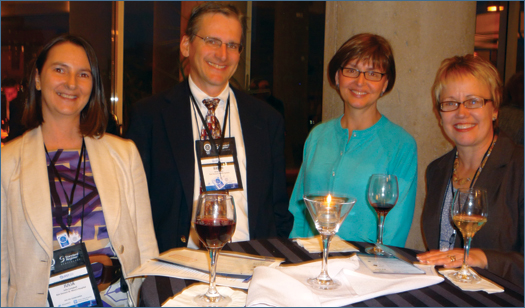Quest 2011: A Rallying Point for Patient Safety Advocates, a Commitment to Reshape Culture
May/June 2011

A Rallying Point for Patient Safety Advocates, a Commitment to Reshape Culture
On March 24, there was an aura of optimism and a sense of empowerment building among a passionate group of doctors, nurses, and hospital administrators who had convened at the Hyatt Regency Baltimore for Quest 2011, sponsored by Standard Register. They had come to this event because they were committed to patient safety. They had come to explore ideas for improving the quality of patient care and creating a culture that fosters patient safety.
Erasing the Lines
Quest was a different kind of forum, where interactivity was encouraged and hierarchical lines that so often exist in a hospital setting were erased as participants sought to untangle the complex issues of delivering safer care. It was an entirely appropriate format for keynote speaker Dr. Peter J. Pronovost and the subject at hand.
“I don’t believe we’ll move the agenda forward until we erase these lines and start aligning forces, guided by a good scorecard and informed science,” Pronovost said.
Pronovost, who is a practicing anesthesiologist and critical care specialist physician, is medical director of the Johns Hopkins Center for Innovation in Quality Patient Care. He is best known for developing a simple, research-based checklist that dramatically reduced the rate of central line-associated blood stream infections (CLABSIs), first in the ICU at Johns Hopkins and then in Michigan, and it is now being rolled out to hospitals across the country, state by state.
Culture is Local
Pronovost stressed that improvements in patient safety must rely on both science and culture change to gain traction and sustain results. He shared the model that was the foundation for the successful CLASBI initiative at Michigan’s Keystone Center for Patient Safety & Quality. It combines robust measurement, a method to put the science into practice (the checklist), and a comprehensive unit-based safety program (CUSP) that relies on the wisdom and commitment of unit clinicians. “Culture is local, and the individual units need to own the problems,” he emphasized.
Borrowing from behavioral scientists, Pronovost follows a four-step approach to facilitate culture change—engage, educate, execute, and evaluate. “To drive change, all the stakeholders must be engaged—senior leadership, team leaders, and frontline staff. They must understand what you’re asking them to do and how it will make the world better. They must know what’s expected of them. It can’t be ambiguous,” he explained.
Tap into the Tribal Knowledge
In planning a CUSP program, Pronovost urged that organizations tap into their tribal knowledge and experience to assure it can be implemented, establishing specific goals, and making people on the unit accountable for results. “You want to make it easy to comply and use metrics your clinicians believe in,” he said.
He reiterated the need for measurement and sharing results, and told the audience to anticipate having to fine-tune the process. “Modifications need to be locally owned,” he emphasized. “External controls are highly resisted and largely ineffective,” he said.
People Want to Do the Right Thing
Pronovost underlined the importance of addressing the adaptive issues, steering clear of judging, blaming, or shaming. “Most people really want to do the right thing. If they can’t, there’s often a barrier that’s preventing them. Our job is to surface [those barriers] and understand them,” he said.
Inspired by Pronovost’s message and methodology, Quest participants joined in table discussions to share their top cultural challenges, exploring underlying problems and ways to address them. In reporting back to Pronovost and the larger group, it was evident many shared the same issues. They determined what is needed is a team approach that respects the contributions of each member without regard for title, a global view with buy-in throughout the organization, greater accountability, transparency, and more focus on protection instead of production.
Aligned in purpose, the table teams then regrouped to brainstorm potential solutions to the challenges, sharing their ideas with the room of energized participants.

Stephanie Dougherty, director of patient safety and patient safety officer for Hunterdon Healthcare of Flemington, NJ, (back row, third from left) understands the importance of alignment and brought her team of clinical unit leaders to Quest for a day of learning and interaction with Dr. Peter Pronovost (front row, center) and other thought leaders.
Courtesy of Standard Register.
The Biggest Barrier: Whether You Believe
Pronovost affirmed their thinking and their determination, saying, “The biggest barrier [to improving patient safety] is whether you believe you can actually you do this. The voice in your head so often says, ‘I can’t do it. I’m afraid.’ This is hard stuff, but whichever one of the voices wins will determine whether we’re going to make healthcare safe. The reality is each of you have in you amazing leadership abilities that can do this.”
The energy and optimism of the morning’s program carried over into the afternoon as Quest participants joined in discussions with two panels of distinguished clinicians and patient safety advocates who are in the thick of reshaping healthcare delivery.
The Power of Committed People
The first discussion, which focused on state collaboratives, offered evidence of the power that groups of committed people can have when they work together to take science to the bedside. Dr. Robert Hyzy, critical care director at University of Michigan Medical School was one of the panelists. He leads the ICU program at Michigan’s Keystone Center for Patient Safety & Quality that first applied CUSP to reduce CLABSI rates. “The state is a good entity around which to rally. It’s something that works when it is animated with purpose,” Hyzy said.
He noted that competition between hospitals never stood in the way of their progress. “We are critical care people. This was a quality improvement initiative. It was important. We ended up having a bandwagon effect in our state. Peter (Pronovost) wanted 20 hospitals. We got 100, and today I can look across the room and see 350.“
“This is not just a strike of lightning,” Hyzy continued. “People are the same everywhere. Well-intentioned people can bond together to make something happen. Today, our collaborative is moving onto sedation delirium, assessment holidays, and early mobility statewide. That was home grown in Michigan. It’s too good to fail,” he said.

Quest sought to stimulate conversation and ideas among panelists and attendees. Shown here (left to right) are Bon Secours St. Mary’s Julia Campbell, director of patient safety and quality; Brian Fillipo, vice president of medical affairs, and his wife, Sherri; and Barb Olson, director of patient safety for HCA’s Clinical Services Group, at the welcome reception.
Courtesy of Standard Register.
The Future Patient Safety
What of the future for others? Though an article published in the April 1, 2011, issue of Health Affairs, “Global Trigger Toll Shows That Adverse Events In Hospitals May Be Ten Times Greater Than Previously Measured,” (Claussen et al.) presents a disturbing picture of the current state of patient care, the Quest panel on “The Future of Patient Safety” offered insights to the challenges and hope for change.
|
Robert Curtis Hyzy, MD Brian H. Fillipo, MD, MMM, FACP Lorri R. Gibbons, RN, BSN, CPHQ Inga Adams-Pizarro |
Dr. Brian Fillipo, vice president of Medical Affairs for Bon Secours St. Mary’s, Richmond, Virginia, observed that healthcare has had 100 years of uninterrupted advances that have improved technology and outcomes, but also made healthcare complex. “Unfortunately, how we deal with reliability in healthcare hasn’t kept pace,” he said.
Over the next 10 years, however, Fillipo expects reliability to improve. “We’re going to become more transparent, more patient-centered, and partner with our families and patients better than we’ve done before. We are going to move from a blame-and-train mentality, and we will measure not just the numbers of errors, but we’ll learn from them so we can anticipate errors going forward.”
The Paradigm is Shifting
Dr. Steve Pratt, chief of the Division of Quality and Patient Safety for the Department of Anesthesia, Critical Care, and Pain Medicine at Beth Israel Deaconess Medical Center (BIDMC) in Boston, sees the paradigm shifting as well. “We will be able to do better at working together in multidisciplinary ways to care for what is best for our individual patients, and for the groups of patients for whom we’re caring, whether they are on our unit, in our hospital, or in our community.”
|
Stephanie Dougherty, RN, BSN Brian H. Fillipo, MD, MMM, FACP Barbara L. Olson, MS, RNC, FISMP Stephen D. Pratt, MD |
He added, “Healthcare reform will require it, and accountable care organizations will help us to do it. Second, we will be better able to do it because of our IT capabilities. Third, I really believe this truly possible.”
Pratt’s conviction comes from the transformation he’s seen at BIDMC where, in 2000, a series of errors during delivery resulted in a prospective mother’s loss of her baby, a hysterectomy, and prolonged hospitalization (Sachs, 2005).
After that, the medical center took a 10-year journey during which it implemented interdisciplinary teams, protocols, drills, and guidelines. Pratt explained,
We’ve completely changed the culture of the way we deliver medicine. It’s a different paradigm for the delivery of healthcare on our labor and delivery unit. We now have multi-disciplinary teams truly working together to care for each patient and to prioritize the care of all the patients. Obstetricians alert anesthesiologists about concerns related to patients that are not even theirs, anesthesiologists help make sure that obstetricians have adequate back-up when they are busy, and nurses help everyone. In addition, we’ve reduced adverse events by 25 percent, and this has been sustained for seven years. So I really believe this is doable.
Podcasts from Quest 2011 were made available to participants via a private web-based hub that Standard Register Healthcare created to facilitate further collaboration. The company will be making portions of the content available to the broader patient safety and quality improvement community through Patient Safety & Quality Healthcare (PSQH), which was exclusive media sponsor for the event. Watch for PSQH e-alerts for notice of their availability.
Christine Winters is communications and media relations manager for Standard Register Healthcare and editor of the company’s quarterly e-newsletter, Insights for Healthcare. She was part of the team that planned and managed Quest 2011. Winters may be contacted at Christine.Winters@standardregister.com.
References
